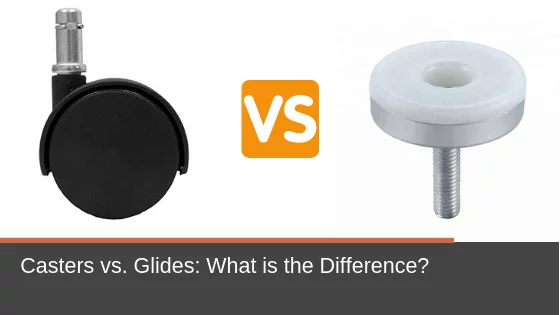When it comes to office furniture, it is essential to know which features will best suit your application. Understanding the critical differences in the details and maintenance of your office furniture, like whether castors or glides are right for your new seating will provide your office with another flexible option for increased comfort and functionality.
What Is a Caster?
Casters are small wheels that are fastened to the bottom of chair legs to facilitate their movement across floors. This type of feature is typically best suited for small, lightweight chairs such as task or conference seating.
The style of casters most commonly used on these sorts of chairs is known as free-wheeling casters. The wheels will continue to move even when weight is applied to them allowing the chairs to be moved around short distances without the user having to stand up.
Free-wheeling casters most often have a swivel feature, which allows the chair to move easily in all directions with very little force applied. Chairs equipped with free-wheeling casters enable employees to enjoy a bit of mobility from their seats to collaborate with colleagues or to adjust their position while working.
Other popular types of casters are called charge-braked and interval-braked casters.
Charge-braked casters allow the furniture’s wheels to roll until weight is applied. Once pressure is applied, the wheels lock and essentially act as a glide until the pressure is removed.
Alternatively, interval-braked casters always provide a slight brake, serving mainly as a safety feature to prevent furniture from rolling away without being purposely moved. Furniture that is fitted with interval-braked casters is typically more significant than, for example, a personal office chair, and requires more force to move than furniture that is equipped with free-wheeling casters.
When to Choose Casters
Virtually any furniture that you will frequently move (usually seating or storage units and pedestals) is a prime candidate for a caster. However, when electing to use a caster for your furniture, it is crucial to consider the flooring on which it will be primarily used.
Nylon casters are often most suitable for carpeted areas, while urethane casters work best on hard surfaces such as wood flooring or tile.
What Is a Glide?
Repairing damaged floors can be expensive and time-consuming. Avoid this hassle by equipping your less frequently moved pieces with glides. Glides are small discs that attach to the bottom of a piece of furniture’s legs, allowing the furniture to “glide” over floors with some force.
Glides are a versatile product that is available in a variety of shapes, sizes, and materials to suit various needs and conditions. Felt glides allow furniture to move smoothly and quietly across surfaces and are generally best suited for hardwood flooring.
Alternatively, nylon or plastic glides work best on carpet or tile flooring. This is because, unlike felt glides, harder materials like nylon or plastic will not snag on carpeting or between tiles and potentially become damaged.
With a straightforward installation process, glides that have become worn down over time can be quickly and easily replaced without the need for a specialist or technician. Merely remove the old glide and fasten the new one onto the bottom of the furniture’s leg with a small nail or industrial strength glue, depending on the glide’s material and the furniture.
When to Choose Glides
Glides are usually made from metal or plastic and are better suited for larger furniture items that only be moved infrequently. For example, glides are an excellent option for lounge-style seating or heavier pieces. Glides allow furniture to be moved easily across surfaces when needed and can be used to help protect flooring from scratches or dents.
Small Details with a Big Impact
Understanding the differences, advantages, and typical applications of any furniture is essential to deciding which type of components is most suitable for your office space. Making the correct decision between using quality casters and glides on your chairs and other office furniture is a simple, inexpensive solution to maximizing the functionality of any space, while simultaneously protecting the condition and longevity of both your furniture and flooring.
Do you have questions about buying office furniture? We answer our most frequently received furniture questions in our comprehensive Office Furniture Buyer’s Guide!
Cory Porteous
Director of Marketing & Inbound Business Development
Office Interiors




